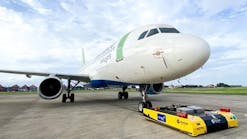Do You Need Aviation Mechanics, Too? Veterans are the Answer
The aviation labor shortage extends much farther than the need for pilots. Another acute issue threatens to harm the industry: the severe lack of aviation mechanics. The urgent demand is alarming, as we could see a deficit of 43,000-48,000 workers, a shortfall of about 24-27%, by 2027.
Compounding the issue is that the aircraft Maintenance, Repair, and Overhaul (MRO) sector is rapidly growing, leading to an even greater need for mechanics. While the growth should be positive news, it can quickly deteriorate if the right talent doesn’t materialize.
An aging population and lower workforce participation rate are impacting industries across the board, and aircraft MROs are no exception. Filling these particular roles, however, also has some unique challenges including a growing resistance by younger generations toward blue collar work, a work environment that can be impacted by extreme weather, lack of hybrid work options, and barriers to entry for newcomers such as FAA licensing requirements and heavy industry regulations. Poaching from competing airlines and independent MROs is heightening the war for talent.
The successful future of the industry requires developing new recruitment strategies and expanding labor pools to help solve these hiring woes. One significant but often overlooked solution is tapping into military personnel who are transitioning to civilian careers. In fact, approximately 100,000 Active Duty service members possess the necessary skills and experience to be eligible for civilian FAA certification.
What Do Veterans Bring to the Table?
There are many reasons to hire military veterans, especially in the MRO field which requires a keen attention to detail, commitment to reliability, and excellent communication skills — all attributes the military instills in its service members. Because the military values soft skills, veterans bring teamwork, integrity, adaptability, resilience, and problem-solving to the civilian workforce.
In the military, technical training for mechanics is rigorous and comprehensive. After completing basic training, aircraft mechanics participate in an advanced training program which includes valuable on-the-job experience with the materials, tools, machines, and equipment needed to maintain and repair commercial aircraft. And military veterans that are trained in aviation mechanics understand the physical rigors of the job and can work in virtually all conditions.
Overcoming the Licensing Challenge
Many organizations are resistant to hiring employees that don’t already have an FAA license. But in a talent crisis like the one facing the aviation mechanic industry today, MROs need to be creative and lean into new approaches including recruiting candidates who are already working to obtain their licenses.
Unlike civilians who need two years of training, veterans are eligible to take the licensing exam right away. One of the biggest hurdles for civilian aircraft mechanics, regardless of whether they go through an FAA-approved school or receive on-the-job training (OJT) in the military, is obtaining the FAA Airframe/Powerplant Mechanic (A&P) certification. While the process is not necessarily complex, it’s expensive and adds more layers to gaining civilian employment that veterans won’t find in other industries such as manufacturing, automotive, alternative energy, mass transit, and trucking.
For most MROs, it’s common knowledge that the A&P licensing process for veterans needs to begin while service members are still on active duty. For those who aren’t as familiar with the steps required, a good place to start is the FAA’s “Becoming an Aviation Mechanic” section of its website. Additionally, the page on “Experience Requirements” has specific details relevant to military personnel, including how active duty service members should document their OJT activities and the process of submitting an application to their local FAA Flight Standards District Office (FSDO). To alleviate the pressure of taking on the licensing process, MROs can partner with third party organizations who are already well-versed in what’s needed and what steps to take.
To expedite licensing, MROs should take an active role in helping both veterans and civilian mechanics navigate the process, and make a financial investment in each individual as well. This could mean covering all or part of the exam fees and prioritizing additional skills training or prep courses to help ensure a passing score.
Building Partnerships for the Win
Whether your company decides to take on the responsibility of hiring veterans itself or chooses to partner with an outside organization skilled in military recruitment such as Orion Talent, it’s important to eliminate as many roadblocks as possible.
One excellent resource is the U.S. Department of Defense, which connects service members and industry partners to offer training and development through its SkillBridge program. An MRO that is an authorized SkillBridge organization can work directly with military personnel during their last 180 days of service to ensure they have the right training to work as a civilian aircraft mechanic and that they’re prepared for the licensing exam upon discharge.
Because active duty SkillBridge participants continue to receive military compensation and benefits, the authorized organization is not under any financial obligation to the service member.
As the talent is trained, they need to be connected with the right career opportunity. Orion has a physical presence on the military bases, which allows its team of experts to talk to potential candidates, get referrals, market career opportunities, and advocate for partner companies looking to hire.
MROs can also partner with local training organizations to help military personnel with additional skills needed beyond their OJT experiences. One notable example is FEAM Aero, a provider of aircraft line maintenance services in the U.S. They recently partnered with Epic Flight Academy to build a new aircraft mechanic training facility at the Cincinnati/Northern Kentucky International Airport to help civilian students launch careers in fuel cargo operations. FAA-eligible military candidates can also benefit from this program and other FEAM initiatives that bring workforce development to both civilians and military veterans to have a positive impact on global MRO operations.
Orion serves as FEAM’s recruiting arm to match military veterans with job opportunities in the aviation industry. FEAM’s Chief Operating Officer Wayne Sisson, who served as an aircraft electrician in the U.S. Marine Corps before transitioning into the Aviation Industry, said, “We have seen the incredible value that military veterans bring to our team. The technical and soft skills gained while on Active Duty have proven a tremendous asset for our organization. Partnering with Orion Talent enables us to better connect with this diverse pool of talent that we so highly value.”
Helping Veterans Transition to the Civilian Workforce
Military personnel are accustomed to a work environment that has defined responsibilities, structured pay and compensation, and a clear path for career advancement. The civilian workforce can be less disciplined, resulting in feelings of culture shock and disillusion for veterans. While veterans tend to leave their first job after service faster than non-veterans, the reason is often underemployment. In the case of military aviation mechanics, however, they are building on their work in the service, so the environment and demands of the job will be familiar to them.
A few additional suggestions on how MROs can support veteran hires include:
● Compensate Them Fairly: According to McKinsey, “of the roughly 150,000 active-duty service members who transition from the military each year, approximately 90,000 earn less in their first year after being discharged than they did on active duty.”
While raising hourly pay may not always be feasible, it’s important to constantly evaluate if salaries are commensurate with experience. For veterans, this means taking their years of service into account when considering starting pay, raises, and advancement opportunities. Additionally, an examination of the total rewards package might reveal areas of improvement beyond salary such as paid-time-off, family leave, sick days, and more.
● Connect Veterans With Veterans: McKinsey also found “the roles with the highest representation of veterans are often analogs of military specialties. These roles include aircraft pilots, flight engineers, and aircraft mechanics and service technicians.” This can be a tremendous advantage for MROs.
Formalizing programs that bring veterans together can be a valuable recruitment and retention tool. This includes soliciting veteran input during the interview process to ensure the right questions are being asked; and as mentioned, to limit any language barriers and disconnects between civilian recruiters and military candidates. Once hired, mentorships and Employee Resource Groups can be valuable programs that help veterans build a safe community where they can share common experiences, discuss unique challenges, and provide support to one another.
● Provide Ongoing Training Opportunities: Professional development is another strength the military offers to its personnel. MROs should explore opportunities, either internally or through outside resources, to invest in, and offer, training such as that of FEAM’s program. There’s also learning experiences that go beyond technical to include training in other disciplines such as leadership, business management, education, mentorship, and DEI. Online, self-directed courses can also be made available to veterans and their families. Offering military spouses learning opportunities and other support systems can be integral to building employee loyalty and increasing retention.
The growth of the aviation market can have a positive impact on the global economy while also connecting people, places, services, and more. But without a well-staffed and resourced team to help ensure the safety, reliability, and modernization of the nation’s aircrafts, the industry risks lapses in service and security that could be costly in many ways. Veterans are a vital resource to building a robust pipeline of aircraft mechanics, who are the backbone of aviation. MROs that prioritize recruiting and retaining military talent will be rewarded with experienced, dedicated, and valuable employees that will help their organizations and the industry thrive.
Collin Hannigan is Vice President at Orion Talent, a veteran-focused recruiting company. He has helped over 100 companies attract and hire the right people. He has also advised hundreds of transitioning veterans and hiring managers on interviewing and hiring best practices to complete successful job matches. Before joining Orion, Collin was a commissioned Artillery Officer in the US Marine Corps. Connect with Collin on LinkedIn or reach him by email.




